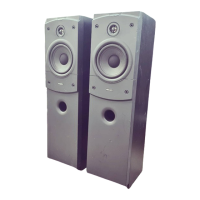
Do you have a question about the Philips Fidelio E6 and is the answer not in the manual?
| Wireless satellite speakers | Yes |
|---|---|
| Number of satellite speakers | 2 |
| Satellite speaker peak power | 180 W |
| Satellite speaker frequency range | 150 - 20000 Hz |
| Satellite speaker mid-range driver diameter | 2.5 \ |
| Satellite speaker woofer diameter (imperial) | 3 \ |
| Weight | 13500 g |
| AirPlay | - |
| Battery type | AAA |
| Built-in HDD | No |
| Package type | Carton |
| Dimensions (WxDxH) | 542 x 220 x 440 mm |
| Packaging tare weight | 3.5 kg |
| Subwoofer frequency range | 20 - 150 Hz |
| Subwoofer driver diameter (imperial) | 6.5 \ |
| Package weight | 17000 g |
| Audio decoders | DTS Digital Surround, Dolby Pro Logic II |
| RMS rated power | 270 W |
| Audio output channels | 5.1 channels |
| Audio formats supported | MP3 |
| Total Harmonic Distortion (THD) | 30 % |
| Product color | Black, Grey |
| Power source type | AC |
| Type of shelf-placement | Laying |
| HDMI version | 1.4 |
| Number of HDMI outputs | 0 |
| Digital audio coaxial in | 1 |
| Consumer Electronics Control (CEC) | EasyLink |
| Cables included | AC, Optical |
| AC input voltage | 110-240 V |
| AC input frequency | 50 Hz |
| Power consumption (standby) | 0.5 W |
| Optical disc player type | Not included |
User manual for Philips Fidelio E6 wireless satellite speakers and subwoofer.
Safety precautions for using the product, including risks of electric shock, fire, and injury.
Guidelines to prevent electric shock or fire hazards when using the product.
Precautions to prevent short circuits or fire hazards.
Instructions to prevent injury and damage to the product.
Guidelines for proper ventilation to prevent overheating.
Precautions regarding battery handling and disposal.
Warnings and instructions for handling coin/button type batteries.
Initiating spatial calibration for listening zone and speaker position.
Steps to connect the left and right base speakers as the main unit.
Instructions for charging the wireless surround speakers.
Identifying the center of the listening area.
Placement advice for the rear surround speakers.
Recommended placement for the subwoofer.
Connecting the TV via HDMI ARC for high-quality audio.
Benefits of using HDMI ARC for superior audio.
Connecting the TV via optical cable for audio playback.
Benefits of using an optical cable for audio.
Connecting the TV via coaxial cable for audio playback.
Connecting the TV via analog audio cables for basic audio.
Connecting an external device via optical cable for audio.
Benefits of using an optical cable for audio.
Connecting an external device via coaxial cable for audio.
Connecting an external device via analog audio cables for audio.
Steps to connect the product to a network for streaming services.
How to stream music from online services to the product.
Situations requiring spatial calibration.
Preparation steps before performing spatial calibration.
Calibrating the listening zone for optimal surround sound.
Calibrating the surround speaker positions for best effect.
How to adjust the volume, mute, and restore sound.
Selecting sound modes for different audio experiences.
Choosing predefined sound modes like MOVIE, MUSIC, VOICE.
Connecting and playing music from Bluetooth devices.
Connecting Bluetooth devices to the main unit.
Using a surround speaker as a standalone Bluetooth speaker.
Resetting the product to its default factory settings.
How to check the current software version.
Updating the product software using an internet connection.
Specifications for the main unit, including power and dimensions.
Specifications for the wireless surround speakers.
Specifications for the wireless subwoofer.
Troubleshooting steps for sound-related issues.
Steps to resolve no sound from the main speakers.
Steps to resolve no sound from surround speakers.
Troubleshooting Bluetooth connection issues.
Steps when a device cannot connect via Bluetooth.
Troubleshooting internet service connectivity.











